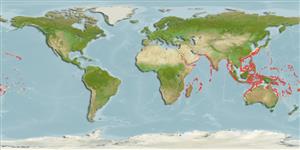>
Eupercaria/misc (Various families in series Eupercaria) >
Lutjanidae (Snappers) > Etelinae
Etymology: Aphareus: Greek, aphareys, -eos = water wings under the belly of female tunna (Ref. 45335).
More on author: Cuvier.
Environment: milieu / climate zone / depth range / distribution range
นิเวศวิทยา
เกี่ยวกับทะเล,น้ำเค็ม เกี่ยวกับหินโสโครก; ระดับความลึก 100 - 330 m (Ref. 37816). Tropical; 35°N - 35°S, 24°E - 150°W (Ref. 55)
Indo-Pacific: East Africa to the Hawaiian Islands, north to the Ryukyu and Ogasawara islands, south to Australia. Southeast Atlantic: Port Alfred, South Africa (Ref. 11228).
ขนาด / น้ำหนัก / Age
Maturity: Lm ? range ? - ? cm
Max length : 110 cm TL เพศผู้/กระเทย; (Ref. 5484); common length : 79.0 cm SL เพศผู้/กระเทย; (Ref. 37816); น้ำหนักสูงสุดที่มีการรายงาน: 11.3 kg (Ref. 4887)
เงี่ยงครีบหลัง (รวม): 10; ก้านครีบอ่อนที่หาง (รวม): 10-11; เงี่ยงครีบก้น 3; ก้านครีบอ่อนที่ก้น: 8. This species is distinguished by the following characters: body elongate and laterally compressed; lower jaw protruding; premaxillae not protrusible, fixed by a frenum; teeth in jaws are extremely small, minute in large adults; roof of mouth toothless; maxilla without scales or longitudinal ridges; interorbital region flattened; gill openings extending far anterior to orbit; gill rakers on first gill arch 16 - 19 + 32-35 = 49-52; last soft ray of both dorsal and anal fins well produced, longer than next to last ray; caudal fin forked; D X,11 (occasionally 10); membranes of dorsal and anal fins without scales; tubed lateral-line scales 69-75. Colour of body blue-grey or mauve to overall reddish; margin of maxilla black; in some specimens, at least, inside of mouth, gill chamber, and gills shining silver; fins yellowish to reddish except pelvic and anal fins sometimes whitish (Ref. 9821).
Adults inhabit reefs and rocky bottom areas to depths of at least 100 m (Ref. 4887). Found in pelagic and benthopelagic waters (Ref. 58302). They feed on fishes, squids and crustaceans (Ref. 4887). Marketed fresh (Ref. 37816).
Life cycle and mating behavior
วัยเจริญพันธุ์ | การสืบพันธุ์ | การวางไข่ | เซลสืบพันธ์ของเพศเมีย(ไข่) | ความดกของไข่ | ตัวอ่อน
Allen, G.R., 1985. FAO Species Catalogue. Vol. 6. Snappers of the world. An annotated and illustrated catalogue of lutjanid species known to date. FAO Fish. Synop. 125(6):208 p. Rome: FAO. (Ref. 55)
IUCN Red List Status (Ref. 130435)
Threat to humans
Harmless
Human uses
การประมง: การค้า; การตกปลาเป็นกีฬา: ใช่
ข้อมูลเพิ่มเติม
ชื่อสามัญชื่อพ้องกลไกการเผาผลาญพลังงานผู้ล่าการศึกษาเกี่ยวกับผลกระทบของสารประกอบทางเคมีที่เป็นอันตรายต่อสิ่งมีชีวิต ประชากร และสิ่งแวดล้อมการสืบพันธุ์วัยเจริญพันธุ์การวางไข่การรวมกลุ่มวางไข่ความดกของไข่เซลสืบพันธ์ของเพศเมีย(ไข่)Egg development
อ้างอิงการเพาะเลี้ยงสัตว์น้ำประวัติการเพาะเลี้ยงสัตว์น้ำสายพันธุ์พันธุศาสตร์ElectrophoresesอัตราพันธุกรรมโรคการแปรรูปNutrientsMass conversion
เครื่องมือ
Special reports
Download XML
แหล่งที่มาจากอินเตอร์เน็ต
Estimates based on models
Preferred temperature (Ref.
123201): 14.1 - 23.3, mean 18.4 °C (based on 229 cells).
Phylogenetic diversity index (Ref.
82804): PD
50 = 0.7500 [Uniqueness, from 0.5 = low to 2.0 = high].
Bayesian length-weight: a=0.01549 (0.01242 - 0.01931), b=2.93 (2.87 - 2.99), in cm total length, based on LWR estimates for this species (Ref.
93245).
ระดับชั้นอาหาร (Ref.
69278): 4.1 ±0.57 se; based on food items.
ความสามารถในการกลับคืนสู่ปกติ (Ref.
120179): ขนาดกลาง, เวลาต่ำสุดที่จะทำให้ประชากรเพิ่มขึ้นเป็น 2 เท่าใช้เวลา 1.4 - 4.4 ปี (K=0.16).
Fishing Vulnerability (Ref.
59153): Moderate to high vulnerability (53 of 100).
Climate Vulnerability (Ref.
125649): High to very high vulnerability (73 of 100).
Nutrients (Ref.
124155): Calcium = 19.9 [11.6, 34.2] mg/100g; Iron = 0.48 [0.26, 0.79] mg/100g; Protein = 19 [17, 21] %; Omega3 = 0.147 [0.094, 0.225] g/100g; Selenium = 57.5 [34.5, 100.0] μg/100g; VitaminA = 80.3 [28.6, 249.2] μg/100g; Zinc = 0.704 [0.502, 0.973] mg/100g (wet weight);
